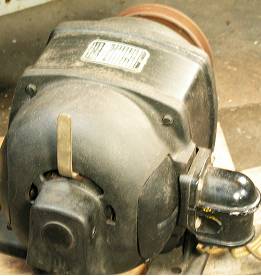Electric Motors – Single Phase, Repulsion Induction and Repulsion Motors
A rarity, a variable speed repulsion motor, with mechanical speed, forward and reverse control lever. A classic, mid 20th century piece of speciality, repulsion induction technology, marking the apogee of the genre – in a period when the genre was still the wonder-boy of single phase, electric motor engineering. Canadian made, it would stand as a special time piece, marking the achievements and sophistication of the Canadian electric motor engineering and manufacturing, part of the “golden years” of the industry in Canada, Leland, 1948.
Features:
– 6 inch pressed steel V pulley for B and C-section belts. The pulley, now badly out of alignment, and showing the signs of rusting, as a result of normal ware and tar, marks these pulleys, fabricated in pressed steel, as best for light duty applications
Technical Significance:
– Variable speed repulsion motor with mechanical speed, forward and reverse control lever.
– A classic, mid 20th century piece of speciality, repulsion induction technology, marking the apogee of the genre – in a period when the genre was still the wonder-boy of single phase, electric motor engineering. For it would be another half century before capacitor start, electronic, digital speed control would be popularly available.
– Canadian made, it would stand as a special time piece, marking the achievements and sophistication of the Canadian electric motor engineering and manufacturing, part of the “golden years” of the industry in Canada,
– Repulsion induction motor technology was above all a marvel of its time, a technology born of both science and the consumer market place, a classic formula for the innovation and diffusion of popular technology, throughout the balance of the 20th century and on in to the 21st. Scientifically, the work of Faraday and many others laid much of the theoretical foundations for electromagnetic devices, the marvel of the early 20th century [much in the same way digital devices became the marvel of the early years of the 21st]. The wonders made possible by alternating current energised, rotating magnetic fields and the electric and magnetic circuitry that made them possible would soon be exploited by those interested in their application in applied electro-motive technology, including Steinnmetz and others. [See References especially #I, 2, and 5]
– But paradoxically, by the mid 20th century the market for high torque, repulsion induction motors, for household and commercial refrigeration applications had peaked. A technology of its times, it represented immense achievement by early 20th century engineers and manufactures. Yet, as is typically the case, with the innovation, dissemination and popularization of technology come the seeds of its own demise. The very means by which its high torque performance had been achieved, through the use of an elaborate wound rotor, commentator and electrical brushes, made it costly, clumsy and noisy, as well as unsuitable for many embedded applications, such as hermetic refrigeration and air conditioning systems. Replacing the commentator and complex rotor windings with a “solid state, squirrel cage” rotor represented a giant engineering advancement. The development of capacitor start electric motor technology [see Classification 12.02] would now quickly replace repulsion induction technology for many applications, well before the end of the 20th century.
Industrial Significance:
– Well recognized for their performance, reliability and maitainability, the repulsion induction engineering designs employed by Leland Electric, Guelph Ontario, along with Wagner Electric Leaside would in many ways serve to characterizing best Canadian practice through middle and later years of the century.
– Because of the specialized nature of the technology, engineering and production costs, and the limited market, few companies would be seen as surviving in the popular, repulsion induction market beyond mid century.


